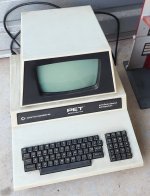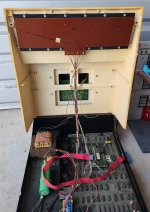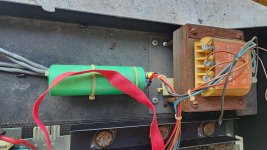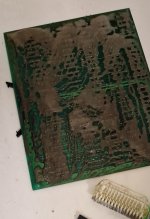Looks like a good dynamic PET that will clean up well.
For the IC's in sockets, their pins will likely need a cleanup and the socket claws checked for tension and cleaned, they are the white single wipe types. And cleaning the connectors. After cleaning, it is the usual things like checking the power supplies first and checking for a normal reset & boot. The upper DRAM bank is in sockets so they can be removed initially and added and checked later. Or the usual tests switching the RAM banks with the CAS signals swapped. Normally people check the hardware first with a NOP generator and then move to the PETTESTER. It would not be a surprise if one or both of the video SRAM chips was defective.
The brush and vacuum gets rid of most of the surface debris. After that it can be required to contact cleaner (such as CRC's CO product) and cue tips to clean up the pcb. If the pcb ends up with a lacklustre look as often they can after extensive surface oxidation and cleaning, its cosmetic appearance can be improved by rubbing it down with a cotton cloth soaked in Inox's MX-3, then using dry cloths to remove that until no more transfers back from the pcb surface to the cloth. The microscopic amount then sits in surface pits and improves the optical appearance of the board, sometimes making it look like new.
(CO contact cleaner completely evaporates, there can be some moisture left from cooling and condensation. On the other hand if you use water, its difficult to get the IC's sockets to dry in a reasonable time frame, it gets trapped in there and accelerates corrosion, for this reason don't put the board in a dishwasher either)
It is highly unlikely that any of the electrolytic caps on this board are defective, don't change them because somebody on youtube says so. On the other hand, the Tant capacitors near the regulators have a penchant for shorting out so they should be checked +/- replaced.
You can treat the rust (on the transformer laminations and elsewhere) by removing most of it with 600 abrasive paper and then painting the surface with a small brush with Fertan organic rust converter (it is a clear yellow fluid that converts the rust into harmless blue-black organic compound). This will also soak into the gaps between the laminations and deactivate the rust there, you can paint over it too if you wish with black paint.
I like that Microtech Portmaker RS232 port add on.
Presumably the ROM Contains everything that makes it work ?
I wonder if that has been reverse engineered, with the pcb, and ROM dump and a manual for its operations or if that is documented anywhere ?













